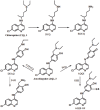Introducing New Antimalarial Analogues of Chloroquine and Amodiaquine: A Narrative Review
- PMID: 28360437
- PMCID: PMC5366359
Introducing New Antimalarial Analogues of Chloroquine and Amodiaquine: A Narrative Review
Abstract
Antimalarial drugs with the 4-aminoquinoline scaffold such as the important drugs, chloroquine (CQ) and amodiaquine (AQ), have been used to prevent and treat malaria for many years. The importance of these drugs is related to their simple usage, high efficacy, affordability, and cost-effectiveness of their synthesis. In recent years, with the spread of parasite resistance to CQ and cross-resistance to its other analogues have decreased their consumption in many geographical areas. On the other hand, AQ is an effective antimalarial drug which its usage has been restricted due to hepatic and hematological toxicities. The significance of the quinoline ring at quinoline-based antimalarial drugs has prompted research centers and pharmaceutical companies to focus on the design and synthesis of new analogues of these drugs, especially CQ and AQ analogues. Accordingly, various derivatives have been synthesized and evaluated in vitro and in vivo against the resistant strains of the malaria parasite to solve the problem of drug resistance. Also, the pharmacokinetic properties of these compounds have been evaluated to augment their efficacy and diminish their toxicity. Some of these analogues are currently in clinical and preclinical development. Consequently, the recent researches showed yet 4-aminoquinoline scaffold is active moiety in new compounds with antiplasmodial activity. Hence, the aim of this review article is to introduce of the novel synthetic analogues of CQ and AQ, which may constitute the next generation of antimalarial drugs with the 4-aminoquinoline scaffold.
Keywords: Amodiaquine; Chloroquine; Drug resistance; Malaria.
Figures








References
-
- World Health Organization. Antimicrobial resistance: Global report on surveillance 2014. Geneva: WHO; 2014. p. 257.
-
- Winzeler EA. Malaria research in the post-genomic era. Nature. 2008;455:751–6. doi: 10.1038/nature07361. [ PMC Free Article] - DOI - PMC - PubMed
-
- Flannery EL, Chatterjee AK, Winzeler EA. Antimalarial drug discovery - approaches and progress towards new medicines. Nat Rev Microbiol. 2013;11:849–62. doi: 10.1038/nrmicro3138. [ PMC Free Article] - DOI - PMC - PubMed
-
- American Psychiatric Association. Diagnostic and statistical manual of mental disorders (DSM–5) Arlington: American Psychiatric Association publishing; 2013. p. 29.
Publication types
LinkOut - more resources
Full Text Sources
Other Literature Sources
